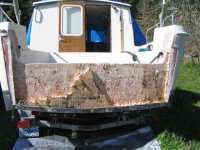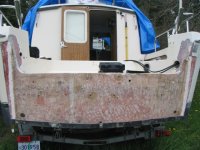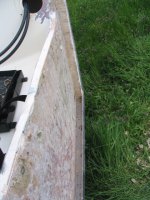stevej
New member
- Joined
- Nov 1, 2003
- Messages
- 314
- Reaction score
- 0
- C Dory Year
- 1995
- C Dory Model
- 25 Cruise Ship
- Hull Identification Number
- DOR25003K495
- Vessel Name
- Shearwater
Took advantage of the sunshine to start removing the outer skin and core from Shearwater.
Took some measurements and connected the markings detailed out in the survey last week for the cutout area.
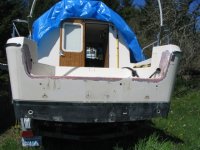
Cut along the dotted line using a 3.5 inch circular saw then sectioned into thirds. The intent was to keep the sections for reference if needed.

Took a bit of prying and pounding but went pretty well. All three sections came off intact.
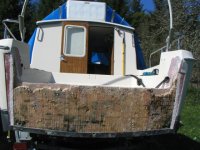
The the balsa in black areas ranges from punky to mush and was totaly saturated with water. The gray areas were wet and had started to delaminate from the skin. I doubt that more than 3 sq/ft of the total area was dry.
Interesting to see the problem areas and how the water migrated.
Looks like the damage was caused by a number of things. The original owner had installed a kicker mount that was not sealed well, and same with the motor well drains. The joint for the side edges of the transom was not completely filled in. When cap cracked water was able to migrate along the edge and find a path to the bottom of the transom.
Starboard side damage
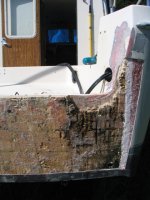
Next week I haul to the shipwright Thomas Becker of Becker Enterprises. Mr. Becker is a true craftsman and I have no doubt that the finished design will be far stronger and the work almost undetectable.
stevej
Took some measurements and connected the markings detailed out in the survey last week for the cutout area.

Cut along the dotted line using a 3.5 inch circular saw then sectioned into thirds. The intent was to keep the sections for reference if needed.

Took a bit of prying and pounding but went pretty well. All three sections came off intact.

The the balsa in black areas ranges from punky to mush and was totaly saturated with water. The gray areas were wet and had started to delaminate from the skin. I doubt that more than 3 sq/ft of the total area was dry.
Interesting to see the problem areas and how the water migrated.
Looks like the damage was caused by a number of things. The original owner had installed a kicker mount that was not sealed well, and same with the motor well drains. The joint for the side edges of the transom was not completely filled in. When cap cracked water was able to migrate along the edge and find a path to the bottom of the transom.
Starboard side damage

Next week I haul to the shipwright Thomas Becker of Becker Enterprises. Mr. Becker is a true craftsman and I have no doubt that the finished design will be far stronger and the work almost undetectable.
stevej

